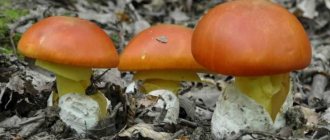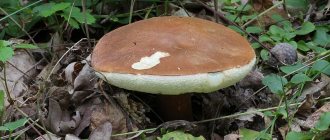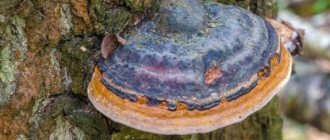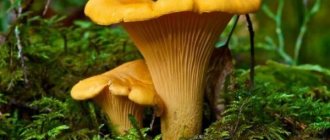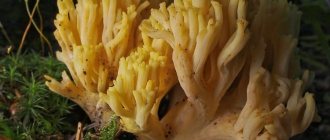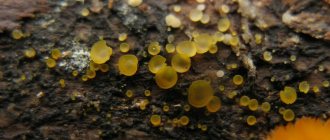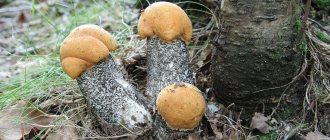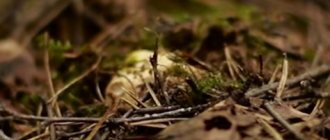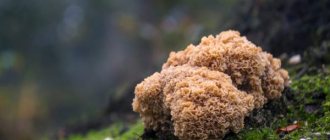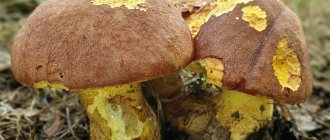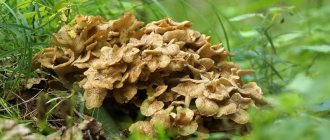Meat for vegetarians - this is what mushrooms are often called by those who are at least partially aware of their beneficial properties. The mushroom that will be discussed further is special. His life, as a rule, lasts no longer than 10 days; on the 7th day after “birth” he is already considered old. And the speed of his growth can be the envy of many living beings on the planet: every day he gains about 4 cm in height and 10 g in weight. But in addition to its extraordinary biological characteristics, the boletus (and this is what we are talking about) also has many properties beneficial to human health.
boletus mushroom
Boletus is a sponge mushroom of the genus Leccinum, which has excellent nutritional and taste qualities, and all representatives of this genus are edible. There are only forty species of boletus in the mushroom kingdom.
Did you know? The boletus grows very quickly. The lifespan of this mushroom is only 10 days. And it becomes “mature” after 6 days.
The boletus has a glossy cap, the color of which can be either white-gray or brown-red, it all depends on the place where it is located. Sun rays, humidity and the type of tree - this is what affects the color scheme of this part of the mushroom. The shape of the cap also varies: in a young specimen it has the appearance of a hemisphere with a white or pinkish tint of flesh, in an older specimen it has a cushion-shaped cap, the flesh is greenish or grayish in color. A mature mushroom can reach 18 cm in diameter.
The stem of the boletus has a rod-shaped shape, slightly expanding downwards. The color of the leg depends on the species and can be white or grayish-white, the entire surface is dotted with plates of gray, brown or even black. The length of the leg of an adult specimen reaches 15 cm, and its flesh is more fibrous and tough.
We recommend reading about processing boletus mushrooms after collection.
White boletus mushroom and its photo
The white boletus mushroom is edible, its cap is up to 3-8 cm, at first hemispherical, then cushion-shaped, later convex. Fleshy, smooth, white or slightly creamy, sometimes with a bluish tint. The surface of the cap is matte, moist in the rain, but not slimy. The skin does not come off. The tubular layer is initially white, then soft light grey. The leg is 6-12 cm long, 1-3 cm thick, at first dense, later hard or even woody, white or light gray, covered with many whitish-brownish scales. The pleasant-tasting pulp is white or slightly greenish; when cut, it does not change color and turns slightly gray.
Look at this boletus mushroom in the photo and continue to study the description:
White boletus mushroom White boletus mushroom
Grows in marshy areas, in mosses. Forms mycorrhiza with birch.
Found from July to October.
It is similar to the inedible gall mushroom (Tyophillusfelleus), but it is bitter, harder with white, pinkish flesh.
White boletus, or bog boletus, is one of the best edible mushrooms; it surpasses the porcini mushroom in terms of digestible protein content. It worms faster than other mushrooms.
Types and names
The boletus belongs to the Boletaceae family and has many species and subspecies.
The most common representatives of this family are:
- common boletus,
- boletus white or swamp,
- boletus is harsh,
- boletus is gray, black and pinkish.
Main distinctive characteristics of the species:
- Places of growth - well-lit areas of young birch forest or mixed forest with a predominance of birch and aspen.
- The shape of the cap is hemispherical in a young mushroom and cushion-shaped in a mature one. The pulp is dense and has a rich mushroom aroma.
- The leg is tight and fleshy, covered with a pattern of plates - scales of various colors. Just like the cap, it has a rich aroma and is suitable for consumption (many gourmets prefer this part of the mushroom).
Did you know? The boletus, like any forest mushroom, forms a symbiosis with the tree under which it grows, protecting it from pests and taking amino acids and carbohydrates from its root system.
Botanical description of the most common species:
- common boletus: brown-red cap on a molded fleshy white straight stem;
- marsh boletus: whitish-gray cap on a thin, sometimes curved stalk;
- boletus is harsh: a cap of dark shades of brown on a massive white stem, thickening at the bottom;
- boletus grey, black and pinkish: the cap (depending on the type) is black, brown or beige-pink on a white elastic stem.
Popular varieties
Modern biologists count about 10 species of boletus growing in various parts of Eurasia.
Gray or Grabovik
This variety differs from the common boletus in the color of its cap. It is known to mushroom pickers as hornbeam, and biologists call it Leccinum carpini. Mushrooms grow in heaps. Young fruits are light gray in color, while older ones are olive or even black. In this case, the tubular layer of the cap will be white. When touched by hands, the lower part of the cap may become covered with purple spots.
A characteristic distinguishing feature of the hornbeam is the change in color of the pulp when broken. Unlike other brothers of the species, it changes color to pink, which after a few minutes turns black.
Multi-colored obabok
This type of mushroom is distinguished by the shape of its cap. If in all boletus mushrooms it stands out well and is perpendicular to the stem, then in the boletus cap the cap has the shape of a dome.
When cut, both the leg and the cap are very fleshy. In old mushrooms of this variety, the stem becomes woody and becomes unsuitable for food. The outer color of the mushroom is matte brown, and the tubular layer changes color as it grows from white to dirty yellow.
Where and at what time does it grow?
The boletus is demanding of humidity and sunlight, so these mushrooms grow in deciduous, mixed and coniferous forests with an advantage of birch and aspen. In addition, boletus mushrooms, like porcini mushrooms, can also be grown in a summer cottage where there are birch trees, bushes, and a lot of light and moisture. The boletus collection season begins in May of early warm summer with thunderstorms and morning fogs and lasts until September.
Find out how long it takes to boil boletus mushrooms.
Locations of the most common species:
- common boletus, stiff boletus - well-lit edges and forest clearings in the depths of deciduous forest and young birch trees;
- boletus boletus - found in swampy areas with very wet soil;
- boletus grey, black and pinkish - grows mainly in well-lit places in birch groves.
Boletus pinkish
This species is native to forested areas of northern Russia and is usually found in late summer or fall.
The color of the caps is from burgundy to brown. The legs of the pink boletus are thin and short, bending in the sunny direction.
Taste and beneficial properties
Boletus, along with the porcini mushroom, is rightfully considered one of the noblest mushrooms, having a unique mushroom aroma, high nutritional value and at the same time low calorie content, and does not lose its taste and beneficial properties during heat treatment, pickling and drying.
Important! Mushrooms contain proteins of both animal and plant origin, making them an excellent meat substitute.
- Useful properties of boletus:
- The main value lies in the high protein content, up to 35%, a highly nutritious substance consisting of amino acids essential for humans, such as arginine, glutamine, isoleucine.
- It is also worth noting the high content of phosphoric acid in this representative of the fungal kingdom, which is involved in the proper formation of the human musculoskeletal system and nervous system and the production of the necessary enzymes to prevent kidney disease, mucous membranes and regulate the concentration of glucose in the blood.
- Contains complexes of vitamins B, C, D, E, which classifies it as a group of antioxidant products that slow down the process of premature aging and the negative effects of free radicals - the main cause of the development of low-quality tumors.
- It is a generous source of fiber, so necessary for the healthy functioning of the digestive system and the removal of toxins from the body.
Video: beneficial and medicinal properties of boletus
Application
The mushroom can be used for medicinal purposes
Boletus is considered a gourmet mushroom, so most people only know about its use in cooking. In fact, this representative of basidiomycetes can be a good substitute for drugs. The fiber and protein content makes it possible to prepare dietary supplements for athletes based on it.
The boletus will be useful in agriculture. After burning the mushroom bodies, ash is formed, which contains calcium, phosphorus, zinc and nitrogen, which provides stable nutrition and prevents the soil from losing its quality. Mushroom products are suitable for formulating feed for cattle, pigs and poultry.
In cooking
The product must be processed before use. First, you should clean it from adhering dirt, remove the skin, and cut off the lower part of the leg. If the product needs to be dried, it should not be washed. Dirt is removed, and then the cap is simply wiped with a damp cloth.
To prevent the product prepared for gourmet dishes from turning blue, after cleaning it is soaked in water with a small amount of lemon juice (juice from 0.5 fruits per 1 liter of water). It does not need to be soaked for several hours like milk mushrooms, 20-30 minutes is enough. The cooking technology involves double boiling. For the first time, you only need to boil the product for 5 minutes after the water boils. Then it is transferred to another pan, a bay leaf, a whole onion, a couple of allspice peas are added, and cooked for 20-30 minutes until fully cooked.
Boiled raw materials are used for pickling, preparing soups, mushroom caviar, salads and other dishes. For the winter, you can prepare dried mushrooms or freeze fresh or boiled products in portions. Storage requires compliance with the following rules:
- dried fruits with signs of mold must be disposed of;
- frozen products are used immediately and are not re-frozen;
- When the brine in the jar becomes cloudy, the product is discarded.
In medicine
In folk medicine, it is used in tinctures and ointments to eliminate pain due to osteochondrosis or gout. The affected areas should be treated 3-4 times a day. Tinctures are taken 2-3 times a day to increase immunity and sexual activity. Individual components of the basidiomycete, together with alcohol, provide an analgesic effect and eliminate nervousness (i.e., they have some sedative effect).
The exceptional properties of this mushroom allow it to be used in the manufacture of weight loss products. In cosmetology, an extract from it is used as a rejuvenating component.
How to distinguish from poisonous counterparts
The boletus has a poisonous counterpart called the false boletus or gall mushroom. Outwardly, it is practically no different from boletus, but has a pronounced bitter taste. It is quite difficult to distinguish it from a true mushroom, but it is possible.
Important! The poisonous twin of the boletus is not deadly, however, if you doubt the correctness of the choice, it is better not to touch it with your bare hands when examining it.
An experienced mushroom picker uses the following steps to recognize gall fungus:
- Place of growth. The Antipode chooses a habitat near stumps, dry trees, ditches and in dark forests with a predominance of coniferous trees.
- State. False boletus is so bitter that neither worms nor insects deign to pay attention to it, so it has no defects, wormholes or other flaws.
- Hat and leg. They are very similar to the noble representative of the third kingdom, however, upon careful examination, some differences can be identified: they are larger than the original; the leg is dotted not with a scaly, but with a mesh pattern, reminiscent of the human vascular system; The pulp has a pinkish oily texture.
- Physical impact. When pressed or cut, the flesh takes on a pink tint, while in true boletus the color of the flesh remains almost unchanged, only slightly darkening.
Useful tips
It’s best to take a wicker basket or a food-grade plastic bucket with you to the forest to pick mushrooms.
It is not recommended to collect it in a plastic bag or canvas bag; you will bring home dented, broken and unsightly-looking forest trophies. It is better not to take mushrooms that you found in some place that is not typical for their growth.
It’s good if you take a camera with you into the forest. After all, posting a photo of boletus mushrooms on your social network page and boasting about a successful trip to the forest to your friends is always a pleasure!
If you have doubts about whether a mushroom is edible, do not risk it and leave it in the forest. Processing of the mushroom “catch” must be started without delay, upon returning home.
Boletus of any kind is suitable for preparing a variety of dishes - stewing, frying, drying or pickling. It makes an excellent mushroom soup.
Freezing works well: taking a bag of mushrooms out of the freezer in winter, you will prepare a fragrant and tasty dish that will remind you of summer!
When and how to collect boletus mushrooms
You can collect boletus a few days after a warm thunderstorm in May, when a damp fog reigns in the forest in the morning. The apogee of collection is moderately hot and dry July, August and September.
Did you know? The first fog of summer is a sure sign of mushrooms.
However, the following collection periods can be distinguished for individual species:
- common boletus, stiff boletus - from June to October until the autumn cold snap;
- marsh boletus - September;
- pink boletus - from August to September.
The frequency of collection varies as follows: two to three weeks of collection occur during the same period of calm.
There are several generally accepted rules for collecting mushrooms that novice mushroom pickers should know; they will not interfere with professionals with impressive experience in “silent hunting”:
- The mushroom, like a powerful pump, absorbs organic substances from the environment, accumulating them. In order to avoid not only poisoning, but also exacerbation of sluggish chronic diseases of the gastrointestinal tract, you should not collect mushrooms growing near highways, factories, cities, etc. The boletus mycelium, for example, absorbs and accumulates cadmium, which is contained in the soil and atmosphere after a forest fire, on the ashes.
- The best time to collect is early morning before dawn. If possible, you can take a preliminary walk through the forest, walk along the paths, examine the forest edges and trees, so to speak, work out a road map. Following the advice of experienced mushroom pickers, the search should begin from the edges, and not from deep forest thickets.
- Keep children in constant sight to prevent them from trying or smelling unknown mushrooms and berries.
- You should also not collect mushrooms in paper, plastic bags or buckets; special wicker baskets, baskets, and backpacks made from natural materials are more suitable for this. It is better to place it on a bottom lined with freshly picked grass, with the stem up to prevent damage to the pulp and access to air.
- Carefully cut or twist the mushroom from the soil for better preservation during transportation and to avoid debris getting on the cut and the cap. The mushroom knife should have a rounded end, not double-edged, with a bright handle and, best of all, with a sheath attached to a belt or basket.
- It is better to collect young, strong and resilient specimens. You should not fill the basket with overgrown, old, wormy, slightly rotten mushrooms, as well as those that are unfamiliar or raise even a shadow of doubt.
- The harvested crop must be processed immediately after harvesting, since boletus quickly deteriorates, worms and has little storage.
Boletus mushrooms in cooking
These mushrooms are considered one of the most delicious (after white mushrooms, with which they are closely related), but during heat treatment they lose their white color and the flesh turns dark. Meanwhile, experienced chefs share a secret: in order to preserve the light color of boletus mushrooms, it is enough to soak them in an acidic solution (with citric acid) before cooking. After this, the mushrooms can be boiled, fried, stewed and not be afraid that they will turn black.
Boletus mushrooms are suitable as a filling for pies. They are extremely tasty when salted or pickled. And dried mushrooms can be used to make excellent mushroom sauces.
But when choosing boletus mushrooms for cooking, it is important to know that when fresh, these mushrooms with loose flesh quickly become wormy. Therefore, you should not leave them in the basket for a long time.
Pickled boletus mushrooms
For this recipe you will need:
- mushrooms – 2.5 kg;
- 9 percent vinegar - one and a half glasses;
- sugar – 5 tsp;
- salt – 2.5 tsp;
- allspice – 5 pcs.;
- black peppercorns – 13 pcs.;
- bay leaf – 3-5 pcs.;
- water – 3 glasses;
- onion – 1 pc.
How to cook
Boil peeled and washed mushrooms in water without salt and spices. Change the water twice during cooking. After boiling, cook for another 15 minutes, adding the onion into the pan (this will help check the edibility of the mushrooms: if the onion remains transparent, then all the mushrooms in the pan are edible). Strain the mushrooms and add water again and add salt. After boiling, cook for another 20 minutes. For the marinade you will need water and vinegar; add chopped onion, salt, sugar, pepper, bay leaf to the mixture and bring everything together to a boil. Place the mushrooms in jars and pour over the hot marinade. Close tightly and leave for a day. That's it - the dish is ready to eat or can wait until winter in jars.
Stewed mushrooms
Boletus mushrooms are one of those mushrooms that are especially tasty when stewed or fried.
Another secret: the most delicious birch mushrooms are made with sour cream. By the way, the famous French julienne in the classic version is made from boletus mushrooms.
For this dish you will need mushrooms pre-boiled in salted water. When cool, fry in a frying pan and add onions and carrots. When all the ingredients are ready, pour in a little sour cream, mix thoroughly and simmer under the lid for another 25 minutes. The finished dish goes well with almost any side dish.
Contraindications
The boletus mushroom is the undoubted leader in nutritional and taste qualities, second only to the porcini mushroom. Eating this product will not cause any harm to a healthy adult, provided that the harvest was carried out in an ecologically clean area, well-known norms and rules, etc. were used during the preparation and procurement process. However, this product is considered difficult to digest due to the presence of chitin, which is a strong allergen.
Did you know? The largest living creature in the world
is
a mushroom belonging to the species Armilaria ostoyae (honey mushroom) and grows in Malheur National Park in Oregon (USA).
The mycelium of this representative of the third kingdom occupies 890 hectares, an area that can occupy 1220 football fields. The age of the super mushroom is
approximately 2400 years.
There are several contraindications for use, namely:
- should not be eaten by children under three years of age due to the high protein content, which can disrupt the child’s enzymatic digestive system;
- people with individual intolerance and allergies;
- people with a history of chronic diseases of the gastrointestinal tract, for example, chronic pancreatitis, dysbacteriosis.
How to identify false boletus
In conclusion, let’s consider an important question for a novice mushroom picker: how to distinguish a real boletus from its double?
To avoid mistakes, you should remember a few simple rules. Firstly, boletus flowers do not like light. If you see a similar mushroom growing in an open place, this is already a reason for doubt.
Secondly, false boletus usually tastes bitter, so worms do not eat them. Examine the mushroom. If it is perfectly clean, with veins on the legs in the form of blood vessels, then most likely you are holding an inedible mushroom in your hands.
Thirdly, a proven way to determine whether it is a real boletus or not is to break the cap. Here the false mushroom will immediately give itself away, starting to noticeably turn blue. And if after this action the flesh has practically not changed, feel free to put the mushroom in the basket.
How to plant and grow a mushroom in the country
Few advanced gardeners manage to grow and propagate boletus in their summer cottage. This is a troublesome task, requiring effort and some knowledge, but believe me, the result is worth it. One of the conditions is the presence of trees in the garden plot; the ideal option is several birch trees. But a garden with other deciduous and coniferous trees, as well as shaded and damp corners, is also suitable. The following are the two most commonly used methods.
Method of cultivation using mushroom mycelium (mycelium)
The expected harvest time is approximately 3 months.
Important! You should not allow the mycelium to dry out even once; this is detrimental to the forest mushrooms you plant in your summer cottage.
Stages of planting and growing:
- Selection and transfer of mushroom mycelium from the forest. This is the most important stage, which has its own secrets of success. The location of the mycelium should be in an environmentally friendly area. A layer with a depth of no more than 35 cm is suitable for carrying. The difficulty is not to disturb the structure of the mycelium, which is why it is better to cut off several small layers rather than one large one. If the mycelium is taken under a forest birch, then it must be planted in a summer cottage under a birch. The same goes for pines, spruces, aspens and other trees.
- Preparing the landing site. Under the selected trees, on the shady side, at a distance of half a meter, a layer of soil 30–40 cm deep is cut off, suitable in size for each individual layer of forest mycelium. The bottom of each recess is lined with a ten-centimeter layer of birch leaves, bark and sawdust; you can also put bird feathers there, which are very rich in phosphorus. The resulting layer should be watered generously.
- Laying mycelium. The forest mycelium is carefully placed at the bottom of the recess, trying not to damage the structure. On top it is covered with the same layer of leaves, sawdust and crushed birch bark that covered the bottom.
- Care. In hot, dry weather, it is necessary to monitor soil moisture, so every day the mycelium planting site is watered to avoid the formation of a dry crust on the soil surface. It is advisable to water with rain or settled water.
Video: how to grow boletus mushrooms in the country
What does boletus look like?
Poisoning from poisonous mushrooms can be fatal due to the highly toxic substances they produce. Therefore, a novice mushroom picker should remember the main characteristics of the mushroom they need: the cap can reach 15 cm in diameter and its color can range from gray to black, including spotted and gray-brown.
The legs of the boletus necessarily have thickenings and scales. The tubular layer of the mushroom depends on age: from white in young growth to dirty brown in mature ones. The flesh of the mushroom is white or pale pink without a pronounced taste or smell.
Anyone who goes into the forest for the first time needs to take a photo of boletus mushrooms so that, in case of doubt, they can visually compare the found individual with the sample.
Depending on the area, the boletus may have a slightly different appearance. For example, in humid deciduous forests, boletus mushrooms are considered to be mushrooms with a thin stalk of olive or brown color.
In dry forests they have thick, scaly legs. In these cases, edibility is determined by the dense and aromatic pulp. Separately, the marsh boletus is distinguished with greenish caps, on thin legs with watery pulp.
Self-cultivation of boletus mushrooms
The famous boletus mushroom can be grown independently, on a garden plot or in a specially designated area, not only for personal use, but also for sale. The business is profitable and does not require much hassle. In addition, compared to other mushrooms, boletus mushrooms are famous for their high yield. You just need to properly care for the garden bed. It is better to plant mushrooms in May-June.
The most difficult thing is to obtain the mycelium of the fungus. Boletus mushrooms are distinguished by the fact that their spores are difficult to separate from the pulp. Knowing this, manufacturers of ready-made mycelium sell boletus substrate ready for planting. This saves the future farmer's time. The cost of a 60 ml package is small - up to 200 rubles. If it was not possible to obtain ready-made mycelium for planting, you need to prepare a mixture that will precipitate the mature spores.
How to germinate mushrooms naturally? First of all, you need to get the spores. They are contained in the mushroom pulp, which must be separated from the cap, minced through a meat grinder and placed in a container with water. Further scheme of action:
- Dry yeast is added to the mixture - a nutrient medium for the propagation of spores.
- The liquid is infused for a week. Then the foam is removed from the surface, the water (the middle part) is drained, and the sediment - these are the spores - is diluted in a new portion of water. Ratio – 1:100.
- This liquid is poured into the birch roots, which must first be opened.
- The area is moistened again.
This is the main condition for germinating mushrooms - maintaining the recommended humidity level. The soil should be sprayed regularly from a spray bottle, simulating mushroom rain. It is advisable to water in the afternoon so that the sun's rays do not dry out the soil. It is good when there are several low plants next to the planting that will protect the clearing from direct exposure to ultraviolet radiation.
The technology for growing boletus mushrooms is to create conditions that are as similar as possible to their natural growth environment.
If ready-made mycelium is available, it can be planted in pre-prepared holes in accordance with the instructions on the package. Don't be overzealous; 3-4 holes for seeds are enough. Their depth is on average 20 cm, diameter - 10. They are placed around the circumference of a tree (birch), preferably not a young one, over 5 years old. It is good when there are several trees, perhaps they are mixed with other species.
How to germinate mushrooms in holes:
- Birch sawdust (or soil with a high peat content) is placed in the prepared holes, followed by forest humus. Then a small piece of compost mycelium is placed. 1/3 of the bag per 1 hole, if the product is ready.
- Each depression is filled and compacted.
- The holes are watered abundantly - at least a liter of water. You can add fertilizer or use preparations containing microorganisms for watering.
- It is also necessary to moisten the soil around the plantings.
- To maintain moisture, the planting is covered with a layer of straw, which is constantly watered, with moss or leaves. The plantation should be moistened at least once a week, at least 3 buckets of water are poured under each hole during this period.
- With the onset of cold weather, straw is replaced with leaves or moss. It is recommended to cover the area within a radius of 2 meters (at least during the first winter) with insulating material: both the holes themselves and tree roots. The covering layer is removed with the first warming.
The planted seeds will produce their first harvest only after a year. After this, active fruiting will be observed for 5-7 years. At this time, you can expand the plantation and make new holes. The volume of the harvest depends on how the growing conditions were maintained. It is also important to choose the right variety of mushrooms that will grow on the site. Their natural distribution area and weather conditions should be similar to artificially created ones.
The advantage of growing boletus mushrooms yourself is the opportunity to harvest young mushrooms. They are tastier, stronger than adult specimens, which become loose over time, and are suitable for any dish - pickling, soup, roast. Timely collection will not allow boletus mushrooms to deteriorate in the garden, lose their valuable taste and be attacked by worms, slugs and other harmful insects.
The boletus is a tasty mushroom that mushroom pickers enjoy hunting for. It is good in any dish, has no contraindications for consumption, and is famous for its excellent taste. Big fans of this mushroom can grow it themselves if they wish. If a birch tree grows on or near your summer cottage, you can plant several beds with pre-prepared mycelium around it, and wait for the results for the next season.
Author of the publication
offline 1 year
Maria Kazennova
0
Publications: 19Comments: 0
Stories about mushrooms for grades 2-3. The world
Porcini
Death cap
Firstly, the base of the leg of the green toadstool and white toadstool (fly agaric) is enclosed in a white “cup” (it is called a volva). Neither russula with a green cap nor champignons have this.
Secondly, the stems of russula and champignons are white and smooth. The leg of the pale green grebe has yellowish-greenish veins and “moiré” stains. The leg of the fly agaric is shaggy and scaly.
Thirdly, the plates of grebes are always pure white and do not change with age.
The green toadstool grows in deciduous, most often deciduous, forests. The stinking fly agaric prefers coniferous forests.
Valuy
The russula family includes a mushroom that is disliked by many for its unpleasant smell. This is valui. Its Latin name translates as stinking russula.
Valui grow in birch forests or forests mixed with birch. Sometimes found in large groups.
Hygrocybe
Umbrella mushrooms
Umbrellas do not have a “cup” or its remains at the base of the stem. And what a wonderful ring the umbrellas have! It can be moved up and down the leg, plus it has three layers and looks like a ballerina's skirt.
Only the mushroom caps are edible; their stems are fibrous and tough.
Mushroom bowls
Raincoats
Langermannia appears on the edges, in meadows, in parks, in the steppes, but rarely. They write about this mushroom in newspapers and show it on TV shows with comments: “This is the enormous size the raincoat has grown to. " However, this is the same as exclaiming at the sight of a tiger: “That’s how big an ordinary cat has grown!” But you and I understand that these are different species!
With age, the pulp begins to turn yellow, green, becomes viscous, and smells unpleasant. Spores ripen inside the mushroom. When fully ripe, the skin on the top of the raincoat breaks, and the spores spill out from the slightest shock: a twig or a raindrop falls, a strong wind blows, or a running hedgehog or hare touches the mushroom. And if you and I touch it, a whole cloud of spores will rise up like smoke. Children call raincoats "grandfather's tobacco" or "wolf's tobacco." Light spores fly through the forest and, falling to the ground, give rise to new myceliums.
Yellow hedgehog
Bile mushroom
There is a mushroom that inexperienced mushroom pickers sometimes mistake for boletus or boletus, and then throw away the dish prepared with it. This is a gall mushroom.
It is not poisonous, but terribly bitter. An attentive person will notice that the mesh on the stalk of the gall mushroom is dark, and not light, like the white one, and the cap is not smooth, but velvety. And its color is dull, yellowish-gray. The bottom of the cap is pinkish, especially on old mushrooms. Remember this and be careful!
Don’t even think about licking a mushroom to determine whether it’s white or its double. You won't get poisoned, but you won't be able to get rid of the bitterness in your mouth for a long time and will spoil the pleasure of a walk in the forest. The deceiver is so bitter that a small piece of it will make any mushroom dish taste bitter.
Winter mushroom
The winter mushroom is often called the winter honey fungus, although it is not related to the honey fungus. It is not only tasty, but also healing. It grows in large “bouquets” at the end of autumn, after leaf fall. The mushroom likes cold weather and is not afraid of night frosts. In the southern regions of the country it can be collected throughout the winter.
The caps of winter mushrooms are a beautiful golden color, the legs seem to be made of brown velvet. The Latin name of the mushroom translated into Russian sounds like velvety-legged fireweed. You can't imagine more precisely!
Only the caps of winter mushrooms are collected for food. Their legs are tough.
Ringed cap
The ringed cap grows from early summer to mid-autumn in completely different forests, up to the forest-tundra and tundra. It is versatile in processing: it can be fried, salted, pickled. Sometimes caps appear in such quantities that in half an hour you can fill a huge basket. Look at the picture, remember this mushroom.
Chanterelle
Mushroom pickers respect this fragrant, elegant mushroom because it is never wormy. Unless the hard larva of the click beetle can be found in its pulp.
Inexperienced mushroom pickers confuse the false chanterelle, or orange talker, with the real chanterelle. It is not poisonous, but has an unpleasant taste. This mushroom is found in late summer and autumn in coniferous forests, sometimes on rotten wood. The hat of the false chanterelle is not yellow, but orange, its edges are smooth, and not curved, like that of a real chanterelle. The plates are frequent, reddish-orange in color. The bright leg in the lower part is darker, brown. This mushroom has an unpleasant odor.
Yellow chanterelles grow in damp and dry weather, in early summer and late autumn, in forests of any type. Wonderful mushroom! It is suitable for all processing methods, but the tastiest are chanterelles stewed in sour cream.
Meadow honey fungus
Oil can
You won't find butterflies in a dense, dark forest. They prefer young groves and like to settle on the sides of forest roads, forest edges, and overgrown fires.
Butterflies grow in large groups and are not difficult to collect. In one clearing you can collect a whole basket. The flesh of the mushrooms is yellowish, fragrant, and does not darken when cooked. The taste is special, as if they had absorbed the aroma of the pine or larch under which they grew. Pickled boletus is good. They make delicious soup and stew. But you shouldn’t dry them: the tender pulp dries out so much that it becomes like stone.
Milkers
The breast is fleshy, thick, its cap can reach 30 cm in diameter (there is information about larger specimens). Compared to other mushrooms, milk mushrooms rarely become wormy. There is something to respect him for! White milk mushrooms grow in birch or forests mixed with birch; they do not like damp places.
But neither black, nor yellow milk mushrooms, nor milk mushrooms can compare in taste and aroma with salted white, or real (raw) milk mushrooms.
Saffron milk caps grow in coniferous forests. The camelina from the pine forest is brighter, pinkish-orange; On the cap of the spruce saffron milk cap, greenish tones predominate, and vague brownish circles are visible. The bright orange milky juice darkens and turns green in the air. The flesh also turns green when fried and salted. But this does not affect the taste at all.
Mosswort
The green flywheel is not a close relative of the yellow-brown flywheel, and it does not grow in moss, but among fallen leaves and pine needles in mixed forests. The green flywheel is found quite often, but rather in small families, rather than in huge groups, like its yellow-brown namesake. The cap of this mushroom is greenish-olive and velvety. The tubular layer is lemon-yellow in color, with large pores, and turns green when pressed. The slightly yellowish flesh does not change color when cut.
fly agaric
Honey fungus
Judging by the name, honey fungus should grow on a stump (about a stump, as they once said). But on trees you can see groups of mushrooms at a height of 4-5 m from the ground. The mycelium crawled there under the tree bark.
In some countries, summer honey fungus is successfully grown on an industrial scale on specially prepared stumps.
False honey fungus
The second difference: the legs are not scaly, like those of the summer honey fungus, and do not widen downward, like those of the autumn honey fungus, but are smooth and even, even narrower at the bottom. There is no ring, sometimes a barely noticeable trace of it is visible in the form of dark lines around the leg.
The third feature of false honey fungus: bright caps without scales. The names of the mushrooms clearly indicate their color. The caps are usually darker in the center.
boletus
The common boletus has a cap measuring 10-15 cm in various shades of brown. In the northern regions, boletuses with almost black or grayish “marbled” caps are often found. The bottom of the cap is light gray or cream with brown spots. The leg is covered with fibrous scales.
Podgruzdok
More often than other types, there are white and black podgrudok, or nigella (black sulk is also called nigella).
The cap of a young black lizard is yellowish-gray; with age it turns brown. The pulp becomes pinkish-gray when cut or broken, then turns black.
Boletus
But the life of the yellow-brown or red-brown boletus is associated with birch. A typical northerner, it grows not only in pure birch forests or forests mixed with birch, but also in heather thickets, in forest-tundra and tundra, even beyond the Arctic Circle (among dwarf birches). The cap of this mushroom is often brick-colored, sometimes very “whitened.”
Polish mushroom
The flesh of the mushroom turns slightly blue when cut, but do not be afraid of this color change. The Polish mushroom is very tasty, many mushroom pickers believe that it is not inferior to the white one, they even call it the Polish white one.
Rogatiki
In autumn, in the spruce and pine forests, hornwort, a small thin fungus of yellowish color, is found. It has been nicknamed mushroom noodle, mace or cockscomb. It grows in large groups among fallen pine needles and is considered edible, although not very tasty.
Ryadovka
In the same places you often come across a soap row. This mushroom is considered inedible. Its cap can be gray or greenish, but this mushroom can be distinguished by its pinkish flesh and unpleasant odor.
Violet row is found only in mid and late autumn (even in November). It is known among mushroom pickers as the blueberry, or titmouse. The cap of this mushroom can be either purple or brown with a lilac tint. The leg is always lilac (light purple).
Blueberries grow not only in forests and parks, but also in gardens, usually in small groups. The taste of the mushroom is sweetish, and the smell is quite strange: fruity and perfumey. Some people like him, others can't stand him. This mushroom is edible without prior boiling, just like other mushrooms.
Pig
Morel, stitch, morel cap
The morel cap is ovoid or conical. It shows convex ribs, between which there are partitions. These ribs and partitions form cells. A cross-section of the mushroom shows that there are cells only on the outside of the cap. The cap and stem are hollow in the middle. The color of the cap is ocher, brownish, but can also be grayish. The stem of the morel is white, with vertical dents, and fragile.
In a morel cap, the cap is put on the stem, like a thimble on a finger; it is attached to the stem only at the top. The stem of the mushroom is long (10-15 cm), smooth, translucent, with small transverse folds. Inside it is hollow or as if filled with cotton wool.
Stropharia blue-green
Russula
Almost all russula have smooth, cylindrical legs. The pulp is white, dense in young fungi, with age it becomes brittle, fragile, and loose. Even if you carefully place the russula in a basket, you can still bring home only the young ones, with an unopened cap, the rest will crumble.
It is best to pickle russulas after scalding them with boiling water. You can fry without pre-boiling.
There are several types of inedible, bitter-tasting russula. They usually have a bright red or reddish cap and a red tint to the stem.
Polypores
Garlic
The meadow honey fungus is small in stature, but it is simply a giant compared to other representatives of the non-rotting genus. The garlic plant, for example, has a cap only 1-2 cm in diameter, and the stem is like a wire. This edible mushroom really smells like garlic. It can be added to various dishes as a seasoning.
But there are non-rotting plants that are several times smaller than garlic grass; they settle on dry blades of grass, needles, and thin twigs. Their caps are no more than half a centimeter in diameter, and their legs are like horsehair or thread! But these little ones are very important for the forest: they gradually turn forest litter into soil.
Champignon
Source
Common boletus: places of growth
The boletus has a “speaking name”, when pronounced, one can unmistakably name the place of its settlement - where birch trees grow.
Mushrooms of this species begin to grow at the very beginning of summer and produce harvests until late autumn. In some years, they are found in abundance in deciduous, birch and mixed forests. There are cases when boletus mushrooms settle where spruce trees grow.
If summer and autumn turn out to be warm and rainy, you can hope for a large harvest, especially under young birch trees. Collecting boletus mushrooms is easy and convenient; they are always in sight and never hide in the grass.
Calories and nutritional value
Boletus mushroom is a low-calorie product and has the following nutritional value (per 100 g of product):
| Name | Quantity, gr. |
| Calories | 31 kcal |
| Carbohydrates | 3,7 |
| Squirrels | 2,3 |
| Fats | 0,9 |
| Macro- and microelements | |
| Potassium | 500 mg. (1/4 daily value) |
| Phosphorus | 200 mg. (1/6 daily value) |
Answers to frequently asked questions from users
How can you tell if a mushroom is old and should not be eaten?
The caps of old mushrooms are more flattened, loose and, as a rule, wormy. If you find such a fruit, place it in a tubular layer on the ground and, if possible, water it with water. This will contribute to better crop yields in subsequent years.
Boletus mushrooms are very tasty and beloved by many mushrooms. Knowing all the details about the time and place of their collection, as well as storage and preparation, you can delight yourself and your loved ones with amazing dishes all year round.
